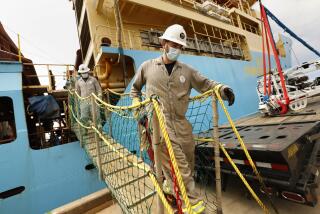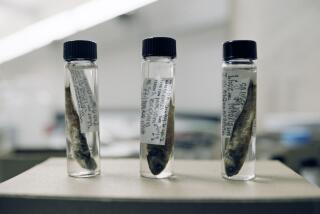Scientists find microbes thriving on plastic marine debris
A team of researchers in Woods Hole, Mass., has discovered a novel ecological habitat flourishing in one of the fastest growing segments of civilization’s toxic waste stream: plastic marine debris.
Welcome to the Plastisphere, a biological wilderness on microbial reefs of polyethylene and polypropylene in the open ocean teeming with single-celled animals, fungi and bacteria, many of them newly discovered. Some may be pathogens hitching rides on floating junk.
The effects of plastic debris on fish, birds, turtles and marine mammals that ingest it are well documented. But little is known about the effects of these diverse, relatively new and evolving microbial communities on the surrounding marine environment.
“We were surprised to find microbes in such high numbers on these plastics,” said Tracy Mincer, an associate scientist in marine chemistry and geochemistry at Woods Hole Oceanographic Institution and coauthor of a report on the findings published online in June in Environmental Science and Technology. “Another surprise was that they are distinct from their surrounding marine counterparts.”
Using scanning electron microscopes and gene sequencing techniques, the team found at least 1,000 different types of bacteria, diatoms and algae attached to seaborne rubbish. They also discovered microbes embedded in cracks and pits on plastic surfaces indicating they may be capable of degrading hydrocarbons.
These unique menageries, which arose on plastic debris introduced to the world’s ocean over the last six decades, make up extensive food chains of bacteria and single-celled animals that produce their own food, bacteria that feed on their waste products and predators that feed on all of them.
“Each one of these plastic bits is a circle of life -- one microbe’s waste is another microbe’s dinner,” Mincer said. “We want to know more about how some microbes may be hanging out on plastic trash, just waiting to be eaten by fish so they can get into that environment.”
Of particular concern was a sample of polypropylene -- about the size of the head of a pin -- dominated by members of the genus vibrio, which includes bacteria that cause cholera and gastrointestinal ailments.
Since plastic debris persists far longer than biodegradable flotsam such as feathers and wood, dangerous pathogens could travel long distances by attaching themselves to plastic rafts of debris tinier than salt grains.
Another surprise: Some microbes seem to have acquired a taste for polypropylene. Others, however, prefer polyethylene.
“We still don’t know what they may be getting out of it,” Mincer said. “Not much nutrition there.”
It’s all grist for continuing research in what Mincer described as “a whole new field of study that is unfolding in countless fascinating themes.”
The analyses of marine debris skimmed with fine-scale nets at several locations in the North Atlantic was led by microbial ecologist Erik Zettler of the Sea Education Assn., biologist Linda Amaral-Zettler of the Marine Biological Laboratory, and Mincer -- all in Woods Hole, Mass.
“We’ve only just begun in what I see as a long-term project in our laboratory,” Mincer said.
An estimated 46,000 pieces of plastic trash float in every square mile of ocean. The waste gathers in vast “garbage patches” in ocean gyres -- cyclonic dead spots formed by currents and winds.
The Eastern Garbage Patch, midway between Hawaii and California, is roughly twice the size of Texas.






